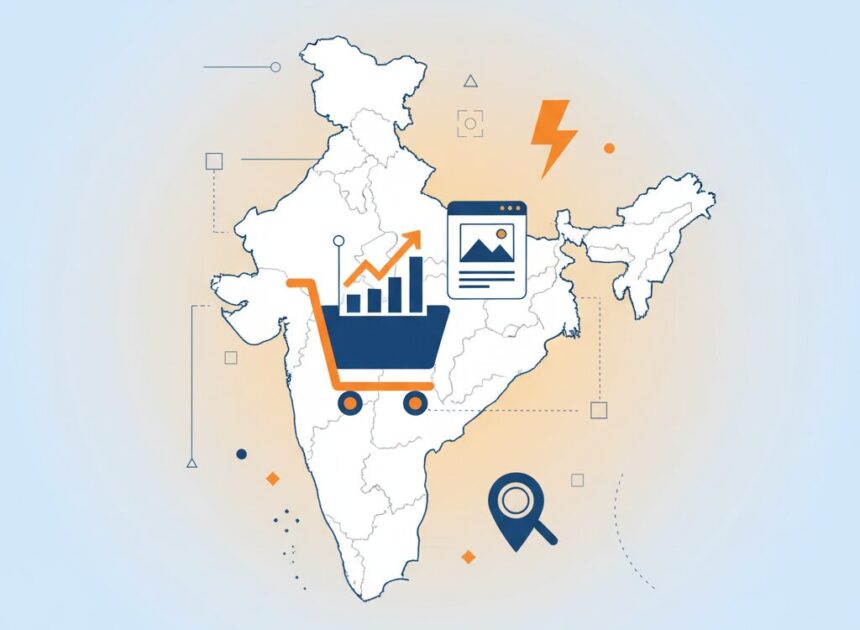India’s e-commerce landscape is not just a marketplace; it’s a battleground. With behemoths like Amazon and Flipkart setting customer expectations sky-high and countless D2C brands emerging daily, the competition is ferocious. For online stores operating from hubs like New Delhi or serving customers nationwide, simply having great products is no longer enough. Visibility is the new currency. How do you ensure your product appears at the very moment a customer is ready to buy? How do you prevent them from abandoning their cart out of frustration? The answer lies in a robust, technically sound e-commerce SEO strategy.
Ranking product pages, optimizing category structures, and fixing site speed are non-negotiable pillars for survival and growth. This playbook moves beyond generic advice and provides a practical, actionable roadmap to lift your organic revenue, enhance user experience, and significantly reduce cart abandonment.
he single best way to start is by understanding your weaknesses. Claim a free, no-obligation 10-point product page audit and our experts will send you a prioritized list of fixes for your top-selling product.
Product Page Fundamentals That Drive Organic Conversions
Your product pages are the digital equivalent of a salesperson. They must be persuasive, informative, and easy for both customers and search engines to understand. Many Indian stores make the critical mistake of using generic manufacturer descriptions and low-quality images, which is a recipe for poor rankings and low conversions. Mastering product page SEO in India is your first and most important task.
Match Search Intent with Precision Keywords
Before you write a single word, you must understand what your customer is typing into Google. Are they searching for a “red silk saree” (a broad category search) or a “Banarasi katan silk saree under ₹5000” (a specific, transactional search)? Your keyword strategy must match this intent perfectly.
- Title Tag: This is your most important on-page SEO element. It should be compelling and structured. A great formula is: Primary Keyword (Product Name) | Category | Brand Name. For example: Handwoven Banarasi Silk Saree | Sarees | Your Brand.
- H1 Heading: Your H1 should be the main headline on the page and closely match the title tag, reinforcing the product’s identity for both the user and Google.
- Meta Description: This is your 160-character sales pitch in the search results. It doesn’t directly impact rankings, but a compelling description that includes the price, a key benefit, and a call-to-action (like “Free Shipping”) will dramatically increase your click-through rate.
Implement Product Schema for Rich Results
Structured data, specifically Product schema, is a type of code that gives Google detailed information about your product. Implementing it allows you to qualify for “rich snippets” in the search results—those eye-catching listings with star ratings, pricing, and availability.
- Key Properties: Your product schema should include name, image, description, brand, sku, and most importantly, offers (with price, priceCurrency, and availability) and aggregateRating (with ratingValue and reviewCount).
- The Conversion Impact: A search result with a 4.5-star rating and a clear price point is far more likely to be clicked than a plain text link. This is a simple technical task that has a direct, measurable impact on traffic and sales.
Write Unique, Persuasive Product Descriptions
This is where you truly sell. Do not copy-paste descriptions from your supplier. This creates duplicate content, which Google penalizes, and fails to connect with your customer.
- Go Beyond Specs: Instead of just listing “100% Cotton,” describe the feel and benefit: “Crafted from 100% long-staple cotton for a soft, breathable feel that keeps you cool during the Delhi summer.”
- Answer Key Questions: Anticipate your customer’s questions. What is the fit like? How do you care for the product? What does it pair well with? Use bullet points for easy scannability.
- Use High-Quality Media: Invest in high-resolution photos from multiple angles, on a clean background, and ideally with a model. A short 30-60 second video demonstrating the product in use can increase conversion rates by over 80%.
Site Speed & Core Web Vitals: The Silent Conversion Killer
In e-commerce, speed equals revenue. A one-second delay in page load time can result in a 7% reduction in conversions. Google knows this, which is why Core Web Vitals are a critical ranking factor. For e-commerce stores, these aren’t just technical metrics; they are direct indicators of your customer’s shopping experience.
- Largest Contentful Paint (LCP): How long does it take for the main product image to load? This should be under 2.5 seconds.
- Interaction to Next Paint (INP): How quickly does the page respond when a user clicks a button, like “Add to Cart” or a color swatch? A lag here is a major point of friction.
- Cumulative Layout Shift (CLS): Do elements on the page jump around as it loads? This is incredibly frustrating for users, especially on mobile, and often leads to them clicking the wrong thing.
Improving Core Web Vitals is a direct strategy to reduce cart abandonment site speed. A faster, more stable site builds trust and keeps the user moving smoothly towards checkout.
Your Site Speed Playbook Steps:
- Audit Your Site: Use Google’s PageSpeed Insights to get a baseline score for your key pages (homepage, category pages, product pages).
- Optimize Images: Compress all images and serve them in next-gen formats like WebP, which offers superior quality at a smaller file size. Use lazy-loading so that images below the fold only load as the user scrolls down.
- Defer Non-Critical JavaScript: Many third-party apps and scripts can slow down your site. Work with a developer to defer the loading of any scripts that aren’t essential for the initial page view.
- Use a Content Delivery Network (CDN): A CDN stores copies of your site’s assets (like images) on servers around the world. For an Indian store, using a CDN with servers in Mumbai, Chennai, and Delhi ensures that customers across the country experience fast load times.
Regional & Vernacular SEO — Capture the Untapped “Bharat” Market
While English-language search dominates the metro cities, the next wave of e-commerce growth is coming from Tier-2 and Tier-3 cities, where users often search in their native languages. This is the “Bharat” opportunity. Regional language SEO is no longer a niche tactic; it’s a mainstream growth channel.
- Identify Demand: Use keyword research tools to analyze search volume for your products in regional languages like Hindi, Tamil, Bengali, or Marathi. You might discover massive, untapped demand. For example, the search volume for “जूते” (shoes in Hindi) is substantial.
- Localize, Don’t Just Translate: A direct translation is not enough. You must understand regional nuances and how search intent differs. A user searching in English might be more brand-conscious, while a user searching in Hindi might be more price-sensitive. Your landing pages and product descriptions must reflect this.
- Technical Implementation: Use hreflang tags on your website. This piece of code tells Google that you have alternate versions of a page for different languages, ensuring that the right version is shown to the right user.
How Revix Solutions Transforms Indian Stores
Navigating the complexities of product optimization, site speed, and regional SEO requires specialized expertise. Revix Solutions provides comprehensive ecommerce SEO services designed specifically for the Indian market. Our approach is data-driven and ROI-focused.
We don’t just deliver reports; we deliver results. Our services include deep-dive product page SEO audits, technical fixes to improve Core Web Vitals, advanced category page optimization, and strategic campaigns for regional keywords. We understand the challenges of faceted navigation SEO and how to implement product schema that gets you noticed.
Start with a clear, actionable first step. Let us show you exactly where the opportunities are.
Request a Free 10-Point Product Page Audit and Get Your Custom Ecommerce SEO PlanFor a broader perspective on market movements, see our analysis of Top E-commerce Trends in the USA for 2025, as many of these trends are leading indicators for the Indian market.







